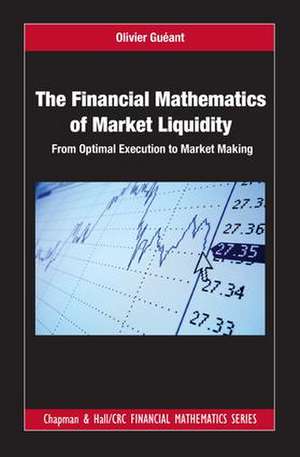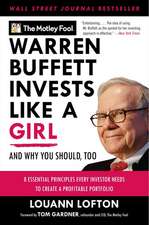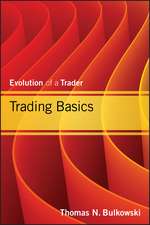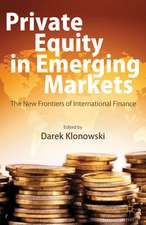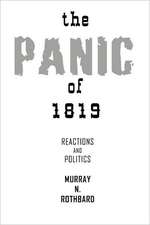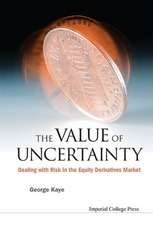The Financial Mathematics of Market Liquidity: From Optimal Execution to Market Making: Chapman and Hall/CRC Financial Mathematics Series
Autor Olivier Gueanten Limba Engleză Hardback – apr 2016
The book introduces the classical tools of optimal execution and market making, along with their practical use. It also demonstrates how the tools used in the optimal execution literature can be used to solve classical and new issues where accounting for liquidity is important. In particular, it presents cutting-edge research on the pricing of block trades, the pricing and hedging of options when liquidity matters, and the management of complex share buy-back contracts.
What sets this book apart from others is that it focuses on specific topics that are rarely, or only briefly, tackled in books dealing with market microstructure. It goes far beyond existing books in terms of mathematical modeling–bridging the gap between optimal execution and other fields of Quantitative Finance.
The book includes two appendices dedicated to the mathematical notions used throughout the book. Appendix A recalls classical concepts of mathematical economics. Appendix B recalls classical tools of convex analysis and optimization, along with central ideas and results of the calculus of variations.
This self-contained book is accessible to anyone with a minimal background in mathematical analysis, dynamic optimization, and stochastic calculus. Covering post-electronification financial markets and liquidity issues for pricing, this book is an ideal resource to help investment banks and asset managers optimize trading strategies and improve overall risk management.
Din seria Chapman and Hall/CRC Financial Mathematics Series
- 9%
 Preț: 641.09 lei
Preț: 641.09 lei - 8%
 Preț: 548.55 lei
Preț: 548.55 lei - 9%
 Preț: 730.39 lei
Preț: 730.39 lei - 8%
 Preț: 459.85 lei
Preț: 459.85 lei - 8%
 Preț: 496.03 lei
Preț: 496.03 lei - 9%
 Preț: 768.95 lei
Preț: 768.95 lei - 9%
 Preț: 704.12 lei
Preț: 704.12 lei - 9%
 Preț: 1213.57 lei
Preț: 1213.57 lei -
 Preț: 356.87 lei
Preț: 356.87 lei - 8%
 Preț: 531.57 lei
Preț: 531.57 lei -
 Preț: 342.37 lei
Preț: 342.37 lei - 9%
 Preț: 716.12 lei
Preț: 716.12 lei - 8%
 Preț: 410.56 lei
Preț: 410.56 lei - 8%
 Preț: 489.60 lei
Preț: 489.60 lei -
 Preț: 364.17 lei
Preț: 364.17 lei -
 Preț: 356.64 lei
Preț: 356.64 lei - 9%
 Preț: 833.53 lei
Preț: 833.53 lei - 9%
 Preț: 609.70 lei
Preț: 609.70 lei - 9%
 Preț: 595.35 lei
Preț: 595.35 lei - 8%
 Preț: 375.01 lei
Preț: 375.01 lei - 9%
 Preț: 574.57 lei
Preț: 574.57 lei -
 Preț: 403.11 lei
Preț: 403.11 lei - 30%
 Preț: 1014.74 lei
Preț: 1014.74 lei -
 Preț: 456.76 lei
Preț: 456.76 lei -
 Preț: 436.14 lei
Preț: 436.14 lei - 13%
 Preț: 310.44 lei
Preț: 310.44 lei - 30%
 Preț: 1014.74 lei
Preț: 1014.74 lei - 12%
 Preț: 312.43 lei
Preț: 312.43 lei - 15%
 Preț: 598.50 lei
Preț: 598.50 lei - 18%
 Preț: 783.69 lei
Preț: 783.69 lei - 15%
 Preț: 570.70 lei
Preț: 570.70 lei - 8%
 Preț: 544.81 lei
Preț: 544.81 lei - 18%
 Preț: 793.01 lei
Preț: 793.01 lei - 24%
 Preț: 900.85 lei
Preț: 900.85 lei - 18%
 Preț: 1280.44 lei
Preț: 1280.44 lei - 22%
 Preț: 371.11 lei
Preț: 371.11 lei - 20%
 Preț: 508.41 lei
Preț: 508.41 lei - 26%
 Preț: 763.78 lei
Preț: 763.78 lei - 20%
 Preț: 1288.30 lei
Preț: 1288.30 lei - 28%
 Preț: 1438.38 lei
Preț: 1438.38 lei
Preț: 608.29 lei
Preț vechi: 668.45 lei
-9% Nou
Puncte Express: 912
Preț estimativ în valută:
116.41€ • 121.09$ • 96.10£
116.41€ • 121.09$ • 96.10£
Carte tipărită la comandă
Livrare economică 14-28 aprilie
Preluare comenzi: 021 569.72.76
Specificații
ISBN-13: 9781498725477
ISBN-10: 1498725473
Pagini: 302
Ilustrații: 31 black & white illustrations, 8 black & white tables
Dimensiuni: 156 x 234 x 22 mm
Greutate: 0.72 kg
Ediția:1
Editura: CRC Press
Colecția Chapman and Hall/CRC
Seria Chapman and Hall/CRC Financial Mathematics Series
ISBN-10: 1498725473
Pagini: 302
Ilustrații: 31 black & white illustrations, 8 black & white tables
Dimensiuni: 156 x 234 x 22 mm
Greutate: 0.72 kg
Ediția:1
Editura: CRC Press
Colecția Chapman and Hall/CRC
Seria Chapman and Hall/CRC Financial Mathematics Series
Public țintă
Professional Practice & DevelopmentCuprins
Introduction. Optimal Liquidation. Liquidity in Pricing Models. Market Making.
Notă biografică
Olivier Guéant is Professor of Quantitative Finance at Ecole Nationale de la Statistique et de l'Administration Economique (ENSAE), where he teaches many aspects of financial mathematics—from classical asset pricing to advanced option pricing theory, to new topics about execution, market making, and high-frequency trading. Before joining ENSAE, Olivier was Associate Professor of Applied Mathematics at Université Paris-Diderot, where he taught applied mathematics and financial mathematics to both undergraduate and graduate students. He joined Université Paris-Diderot after finishing his PhD on mean field games, under the supervision of Pierre-Louis Lions.
He progressively moved to Quantitative Finance through the publication of research papers on optimal execution and market making. Olivier is also a renowned scientific and strategy consultant, who has taken on projects for many hedge funds, brokerage companies, and investment banks, including Credit Agricole, Kepler-Cheuvreux, BNP Paribas, and HSBC. His main current research interests include optimal execution, market making, and the use of big data methods in Finance.
He progressively moved to Quantitative Finance through the publication of research papers on optimal execution and market making. Olivier is also a renowned scientific and strategy consultant, who has taken on projects for many hedge funds, brokerage companies, and investment banks, including Credit Agricole, Kepler-Cheuvreux, BNP Paribas, and HSBC. His main current research interests include optimal execution, market making, and the use of big data methods in Finance.
Recenzii
"This excellent monograph covers the mathematical theory of market microstructure with particular emphasis in models of optimal execution and market making. Gueant’s book is a superb introduction to these topics for graduate students in mathematical finance or quants who want to work in execution algorithms or market-making strategies."
—Jose A. Scheinkman, Charles and Lynn Zhang Professor of Economics, Columbia University, and Theodore Wells '29 Professor of Economics Emeritus, Princeton University
"This is a very timely book that cuts across various fields (applied mathematics, operations research, and quantitative finance). Execution costs due to market illiquidity can significantly reduce returns on investment strategies and, for this reason, affect asset prices. It is therefore important to design trading strategies minimizing these costs and to account for their effect on prices. In the last decade, ‘quants’ and researchers in quantitative finance have made considerable progress on these issues, integrating in their models changes in the way financial markets work (e.g., the development of continuous limit order books, market fragmentation, dark pools, the automation of trading, etc.).
"Olivier Guéant’s book takes stock of this effort by providing a rigorous and expert presentation of mathematical tools, models, and numerical methods developed in this area. I strongly recommend it for researchers and graduate students interested in how illiquidity costs affect trading strategies and should be accounted for in asset valuation problems."
—Thierry Foucault, HEC Foundation Chair Professor of Finance, HEC, Paris
"This book is a must-have for quantitative analysts working at algorithmic trading desks. Olivier Guéant could have written a sophisticated book dedicated to cutting-edge research. He rather decided to put his talent at the service of a far more difficult task: deliver a clear view of modern algorithmic trading to strats or quants having decent scientific training. Scientists will find here all the needed keys to control the intraday risk of their trading models, improving their overall efficiency. Covering brokerage algorithms, market making, hedging, and share buyback techniques, this book is the definitive reference for algorithm builders.
Moreover, Olivier links algorithmic trading with market microstructure during the first chapter of the book, including interesting thoughts on corporate bonds trading. On the other hand, he provides a nice introduction to mathematical economics in the Appendix. This book is resolutely more than a bunch of equations thrown on blank pages. I consider it an important step forward in the building of the mathematics of market microstructure."
—Charles-Albert Lehalle, Senior Research Advisor, Capital Fund Management
—Jose A. Scheinkman, Charles and Lynn Zhang Professor of Economics, Columbia University, and Theodore Wells '29 Professor of Economics Emeritus, Princeton University
"This is a very timely book that cuts across various fields (applied mathematics, operations research, and quantitative finance). Execution costs due to market illiquidity can significantly reduce returns on investment strategies and, for this reason, affect asset prices. It is therefore important to design trading strategies minimizing these costs and to account for their effect on prices. In the last decade, ‘quants’ and researchers in quantitative finance have made considerable progress on these issues, integrating in their models changes in the way financial markets work (e.g., the development of continuous limit order books, market fragmentation, dark pools, the automation of trading, etc.).
"Olivier Guéant’s book takes stock of this effort by providing a rigorous and expert presentation of mathematical tools, models, and numerical methods developed in this area. I strongly recommend it for researchers and graduate students interested in how illiquidity costs affect trading strategies and should be accounted for in asset valuation problems."
—Thierry Foucault, HEC Foundation Chair Professor of Finance, HEC, Paris
"This book is a must-have for quantitative analysts working at algorithmic trading desks. Olivier Guéant could have written a sophisticated book dedicated to cutting-edge research. He rather decided to put his talent at the service of a far more difficult task: deliver a clear view of modern algorithmic trading to strats or quants having decent scientific training. Scientists will find here all the needed keys to control the intraday risk of their trading models, improving their overall efficiency. Covering brokerage algorithms, market making, hedging, and share buyback techniques, this book is the definitive reference for algorithm builders.
Moreover, Olivier links algorithmic trading with market microstructure during the first chapter of the book, including interesting thoughts on corporate bonds trading. On the other hand, he provides a nice introduction to mathematical economics in the Appendix. This book is resolutely more than a bunch of equations thrown on blank pages. I consider it an important step forward in the building of the mathematics of market microstructure."
—Charles-Albert Lehalle, Senior Research Advisor, Capital Fund Management
Descriere
This book is devoted to mathematical models for execution problems in finance. The book presents a general framework—inspired by the Almgren-Chriss approach—for optimal execution problems and demonstrates its use across a wide range of areas. The book covers applications to the different types of execution proposed within the brokerage industry. It also presents applications to block trade pricing, option pricing and hedging, and the management of complex buy-back contracts.
